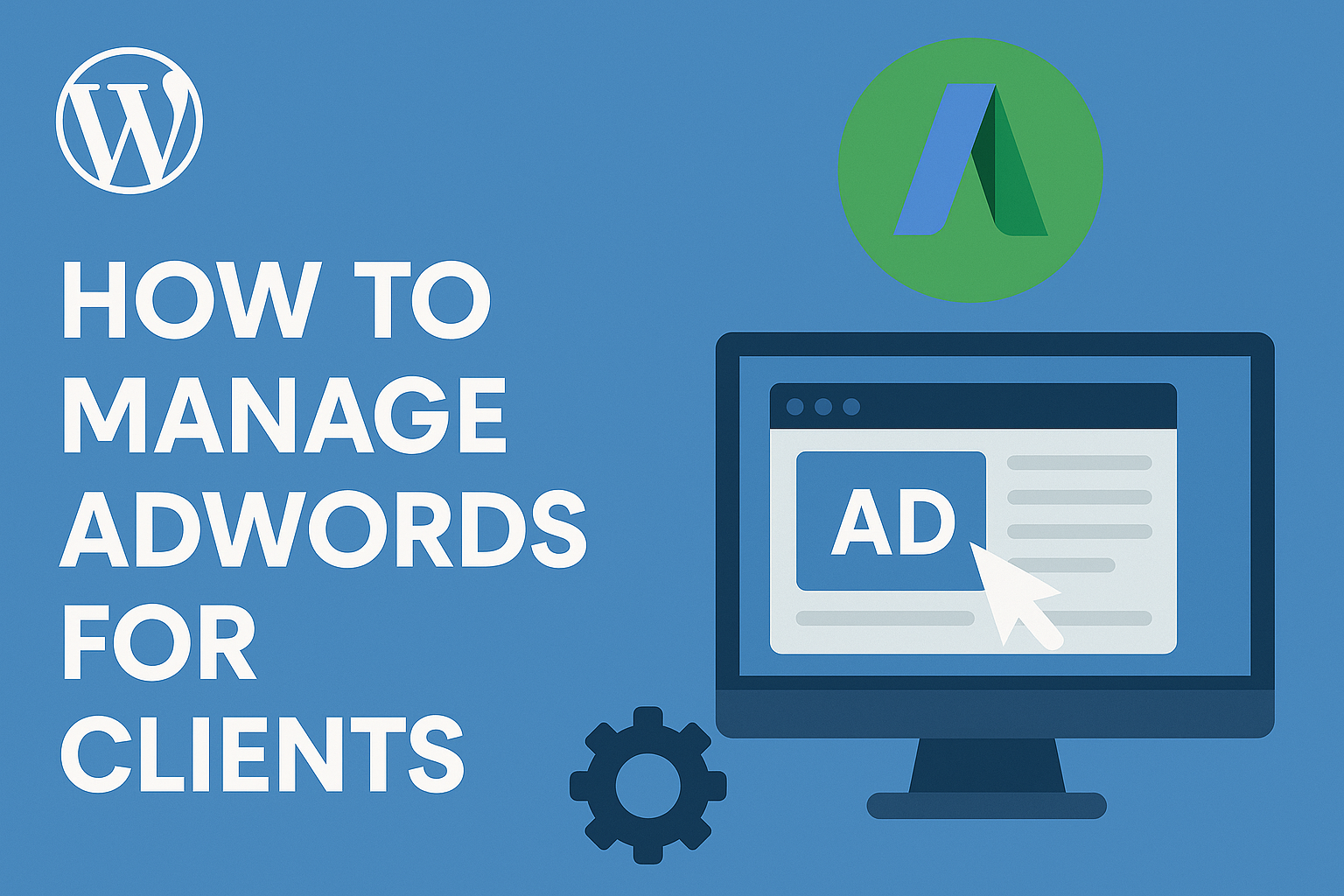For small agencies, managing Google Ads (formerly AdWords) for multiple clients can quickly become overwhelming without a clear system in place. With limited time and resources, every account needs to be handled efficiently, transparently, and with consistent performance in mind.
Whether you’re managing five clients or fifty, having a streamlined workflow is essential for delivering results and retaining accounts long-term. From onboarding and campaign setup to optimization and reporting, each step must be intentional.
This guide outlines a practical workflow that small agencies can follow to manage Google Ads accounts professionally—while staying lean and scalable.
Initial Setup and Access Management
The first step in managing any client’s Google Ads account is setting things up correctly. This avoids future technical issues, ensures accurate data, and builds immediate trust with your client.
1. Use a Google Ads Manager Account (MCC)
If your agency isn’t using a Google Ads Manager Account, set one up. It allows you to manage multiple client accounts from one dashboard without needing their login credentials.
2. Request Proper Account Access
Request “Admin” or “Standard” access to the client’s existing account via your MCC. If they don’t have one, help them create a new account under your MCC to retain ownership and simplify billing.
3. Set Up Conversion Tracking
Install conversion tracking early—before running any ads. Use Google Tag Manager (GTM) to install tags like:
- Google Ads Conversion Tags
- Google Analytics or GA4 Events
- Phone call tracking or lead form submissions
Test conversions using Google’s Tag Assistant to confirm data is being recorded.
4. Link Google Tools
Ensure you link the following accounts for better reporting and audience targeting:
- Google Analytics (GA4)
- Google Tag Manager
- Google Business Profile (for location extensions)
- Google Merchant Center (for eCommerce)
A clean and complete setup creates the foundation for measurable and manageable PPC performance.
Campaign Structure and Keyword Planning
A well-structured campaign improves performance, simplifies management, and makes optimization easier over time. For small agencies juggling multiple clients, consistency in structure is key.
1. Choose the Right Campaign Type
Start by selecting the most relevant campaign type for the client’s goals:
- Search Campaigns: Ideal for lead generation and local services
- Performance Max: Useful for eCommerce or multi-channel reach
- Display and Remarketing: For brand awareness or retargeting past visitors
- YouTube Ads: For video campaigns with strong creative assets
Avoid launching multiple campaign types at once unless the budget and business model support it.
2. Organize by Intent and Product/Service
Break campaigns into logical categories. For example:
- A home services client might have campaigns for “emergency plumbing,” “water heater repair,” and “drain cleaning.”
- An eCommerce store could separate campaigns by product category or brand.
Keep ad groups tightly themed to maintain relevance between keywords, ads, and landing pages.
3. Use the Right Match Types
Combine match types strategically:
- Exact match for precise control
- Phrase match for mid-level flexibility
- Broad match (with caution) when combined with smart bidding and conversion data
Avoid relying on broad match too early unless you have enough data and budget to justify it.
4. Set Initial Budgets and Bidding Strategy
Start with a daily budget that allows at least 10–20 clicks per day, depending on CPC. Use manual CPC or Maximize Clicks for early control, then switch to automated bidding (e.g., Maximize Conversions) once you have enough conversion data.
A thoughtful structure up front saves time later and improves long-term campaign performance.
Writing Effective Ads and Extensions
High-performing ads are critical to campaign success. For small agencies, developing a repeatable process for writing ad copy and using extensions can boost results and streamline workflow.
1. Use Responsive Search Ads (RSA) Strategically
Since RSAs are now the standard, write multiple headlines and descriptions that highlight:
- The core offer or USP (e.g., “Free Quote in 24 Hours”)
- Trust signals (e.g., “20+ Years of Experience,” “Google Certified”)
- Keyword relevance (“Plumber in San Diego”)
- Strong calls to action (“Call Now,” “Get a Free Estimate”)
Test different combinations, and pin essential text (like the brand or CTA) in headline position 1 if needed.
2. Align Ads with Ad Group Themes
Make sure each ad mirrors the keywords in its ad group. This increases Quality Score and click-through rate (CTR).
For example, in a “water heater repair” ad group, headlines and descriptions should include that exact phrase and related language.
3. Add and Optimize Ad Extensions
Use every relevant extension to expand your ad’s footprint and provide extra info:
- Sitelink Extensions (link to pricing, about page, services)
- Callout Extensions (e.g., “No Hidden Fees,” “Licensed & Insured”)
- Structured Snippets (e.g., list of services)
- Call Extensions (especially for local service clients)
- Location Extensions (if targeting local customers)
Google favors ads with extensions—they improve performance and increase visibility.
4. Review and Rotate Creatives Regularly
Even automated ad rotation needs fresh input. Review ad performance monthly and test new messaging, especially for low CTR or low conversion ads.
Well-written, relevant ads and fully built-out extensions give campaigns a competitive edge and improve campaign ROI from day one.
Ongoing Optimization and Budget Management
Once campaigns are live, consistent optimization is what keeps performance strong and clients happy. For small agencies, having a weekly and monthly optimization routine is essential.
1. Weekly Optimization Tasks
Check performance at the ad group and keyword level. Focus on:
- Search terms report: Add negative keywords to block irrelevant queries
- CTR and Quality Score: Pause low-performing ads and refine messaging
- Bid adjustments: If using manual bidding, raise bids on converting keywords, lower bids on underperformers
- Budget pacing: Ensure campaigns are spending evenly across the month
Avoid making large-scale changes too frequently—let data accumulate before taking action.
2. Monitor Conversion Data
Always optimize based on meaningful conversions—not just clicks.
- Confirm conversion tracking is working properly
- Review cost-per-conversion (CPA) and conversion rates
- Shift budget toward campaigns or ad groups with lower CPA and better return
3. Adjust Bidding Strategy Over Time
Once a campaign has enough conversion data (typically 15–30 conversions in 30 days), consider switching from manual bidding to smart bidding strategies:
- Maximize Conversions
- Target CPA (if conversion volume is stable)
- Target ROAS (for eCommerce accounts)
4. Test Continuously
Test new headlines, descriptions, and landing pages. Document changes so you know what influenced results.
5. Optimize Device, Location, and Time Settings
Use campaign-level data to apply bid adjustments based on device performance, geographic regions, and ad schedule insights.
Staying on top of these optimization tasks ensures campaigns stay efficient and continuously improve.
Reporting and Client Communication
Clear, consistent reporting keeps clients informed and builds long-term trust—especially for small agencies competing with larger firms. Avoid jargon and focus on what matters to the client.
1. Use Simple, Goal-Focused Reports
Clients care about outcomes, not impressions or Quality Scores. Build reports that highlight:
- Total ad spend
- Conversions (leads, sales, calls)
- Cost per conversion
- Return on ad spend (for eCommerce)
- Month-over-month changes and insights
Tools like Google Looker Studio (formerly Data Studio) are ideal for creating automated, visual dashboards clients can access anytime.
2. Set a Regular Reporting Schedule
Most clients are fine with monthly reports, but send quick summaries mid-month if something notable happens (spike in conversions, major account changes). Use a consistent format and send it the same time each month.
3. Include Commentary and Recommendations
Don’t just send numbers. Include 2–3 bullet points summarizing:
- What worked
- What didn’t
- What you’re doing next
Example:
“Your cost per lead dropped 18% this month after tightening keywords. Next, we’ll test new ad copy and a landing page variation to improve conversion rate.”
4. Maintain Open Lines of Communication
Offer a quick monthly call to review results—especially for high-value clients. Be honest, proactive, and explain data in plain terms.
A strong reporting routine positions your agency as transparent and results-driven, making it easier to retain and upsell clients over time.
Tools and Processes to Stay Efficient
Small agencies must do more with less. The right tools and internal processes help you manage multiple accounts without burning time or sacrificing quality.
1. Use Google Ads Editor for Bulk Changes
Google Ads Editor allows you to make bulk edits offline, then push them live. It’s ideal for:
- Updating ad copy across multiple campaigns
- Adding keywords or negative keywords in bulk
- Copying campaigns between accounts
2. Automate with Rules and Scripts
Google Ads offers automated rules for repetitive tasks like:
- Pausing low-performing ads
- Budget alerts
- Scheduling bid adjustments
For more control, use Google Ads Scripts to automate deeper functions (e.g., account health checks or anomaly detection).
3. Create Standard Operating Procedures (SOPs)
Systematize recurring tasks like:
- Weekly optimization
- Monthly reporting
- Campaign launch checklist
Having SOPs ensures consistency and allows team members to step in without confusion.
4. Use Looker Studio for Scalable Reporting
Build one dashboard template and clone it for each client. Automate updates so your team doesn’t waste hours each month creating PDFs or screenshots.
5. Project and Task Management Tools
Use tools like Trello, Asana, or ClickUp to track tasks across clients. Create templates for campaign builds, audits, and onboarding to move faster.
6. Centralize Communication
Keep client emails, Slack channels, and notes organized by account. Consider using a CRM like HubSpot or Pipedrive to track conversations and follow-ups.
Efficiency is a competitive advantage. With the right tools and systems, your agency can deliver better results in less time—without needing a large team.
Conclusion
Managing Google Ads for clients as a small agency requires more than just platform knowledge—it demands a clear, repeatable workflow. From onboarding and setup to ongoing optimization and client reporting, every step should be designed to save time, improve performance, and build trust.
With the right structure, tools, and communication processes in place, your agency can confidently scale its PPC services—without sacrificing quality or burning out your team.
Follow this workflow consistently, and you’ll not only deliver better results but also build longer, more profitable client relationships.

